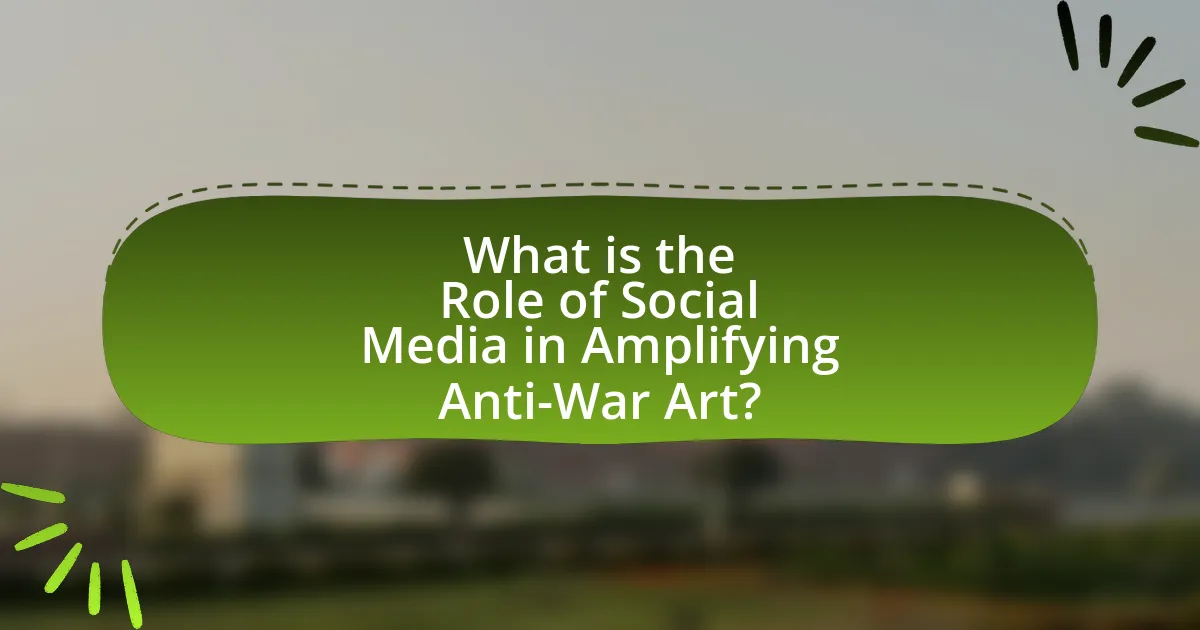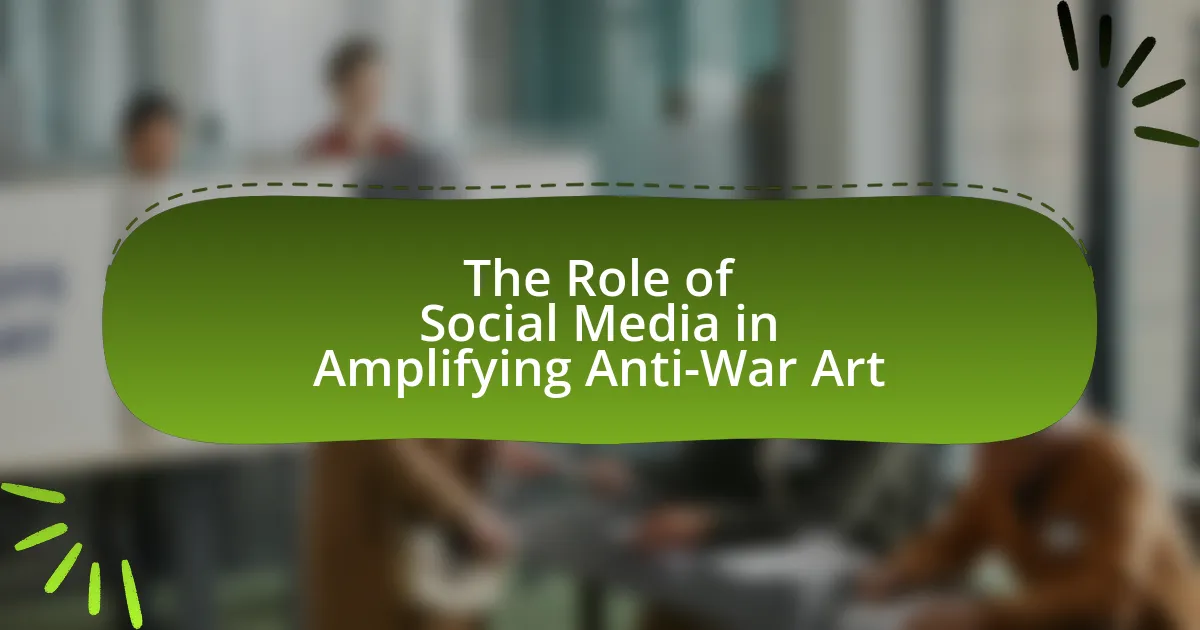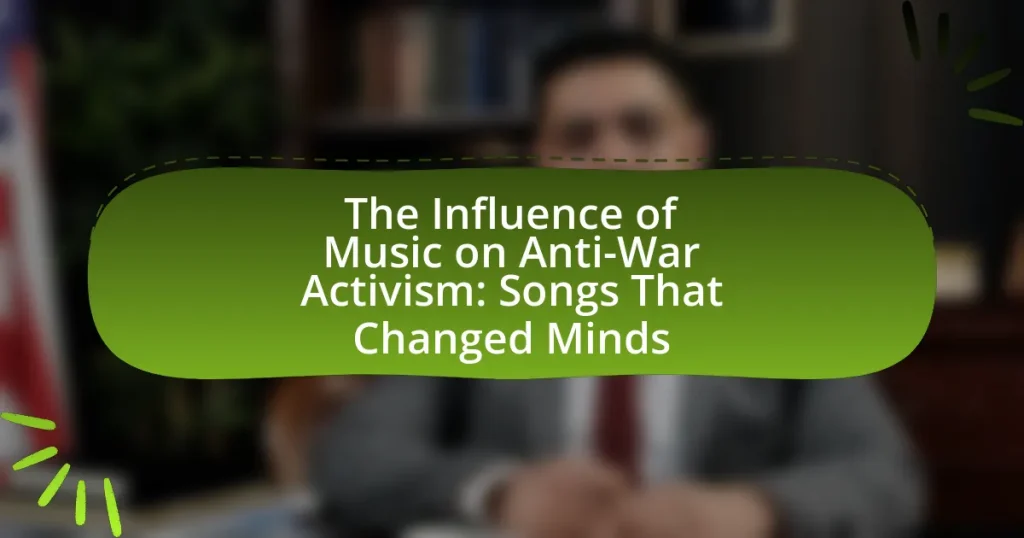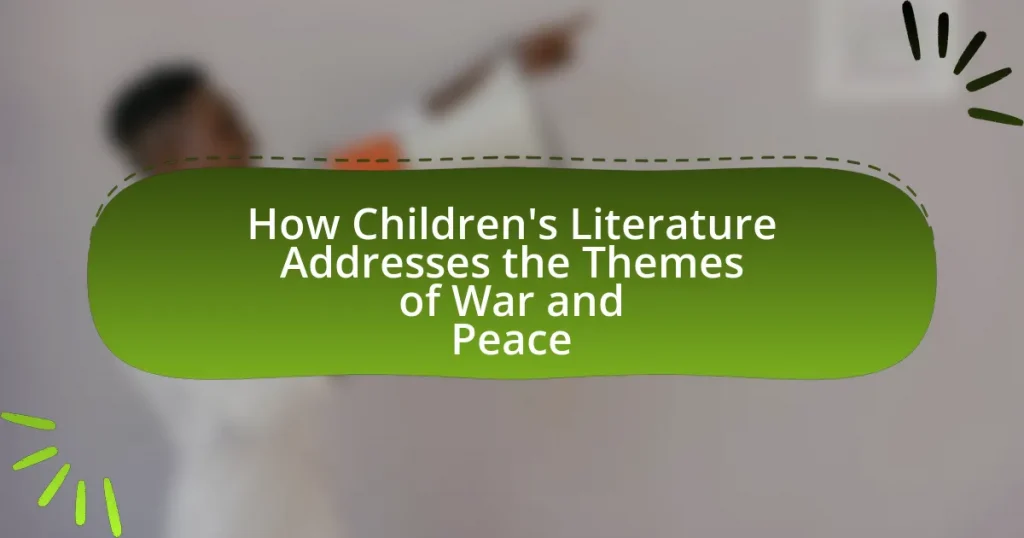The article examines the significant role of social media in amplifying anti-war art, highlighting how platforms like Instagram, Twitter, and Facebook facilitate the widespread dissemination and engagement of artistic expressions against war. It discusses the effectiveness of these platforms in enhancing visibility, fostering community dialogue, and mobilizing activism, particularly during events like the Iraq War. Additionally, the article addresses challenges faced by anti-war artists, such as censorship and algorithmic bias, while offering strategies to overcome these obstacles and maximize impact. The implications of social media for the future of anti-war art and grassroots movements are also explored, emphasizing the potential for emerging technologies to further enhance engagement and visibility.

What is the Role of Social Media in Amplifying Anti-War Art?
Social media plays a crucial role in amplifying anti-war art by providing a platform for widespread dissemination and engagement. Through platforms like Instagram, Twitter, and Facebook, artists can share their work with a global audience, bypassing traditional gatekeepers such as galleries and museums. This democratization of art allows for diverse voices and perspectives to be heard, fostering community dialogue and activism. For instance, during the Iraq War, hashtags like #NoWar and #ArtForPeace enabled artists to connect and mobilize support, demonstrating the effectiveness of social media in rallying public sentiment against conflict.
How does social media influence the visibility of anti-war art?
Social media significantly enhances the visibility of anti-war art by providing a platform for widespread sharing and engagement. Platforms like Instagram, Twitter, and Facebook allow artists to reach global audiences instantly, bypassing traditional gatekeepers such as galleries and museums. For instance, the viral nature of social media can lead to rapid dissemination of anti-war artworks, as seen during the Iraq War protests when images and videos circulated widely, garnering millions of views and shares. This democratization of art distribution enables diverse voices to contribute to the anti-war narrative, fostering community discussions and activism around the subject.
What platforms are most effective for sharing anti-war art?
Social media platforms such as Instagram, Twitter, and Facebook are most effective for sharing anti-war art. These platforms allow artists to reach a wide audience quickly, facilitating the dissemination of visual content that can evoke strong emotional responses. For instance, Instagram’s visual-centric format enables artists to showcase their work through images and videos, while Twitter’s rapid sharing capabilities allow for real-time engagement and discussions around anti-war themes. Additionally, Facebook groups and pages can foster community support and collaboration among artists and activists, amplifying their messages. The effectiveness of these platforms is evidenced by numerous campaigns, such as the #ArtForPeace initiative, which successfully mobilized artists globally to share their anti-war messages through social media channels.
How do algorithms affect the reach of anti-war art on social media?
Algorithms significantly influence the reach of anti-war art on social media by determining which content is prioritized in users’ feeds. These algorithms analyze user engagement metrics, such as likes, shares, and comments, to promote posts that are likely to generate more interaction. Consequently, anti-war art that resonates with a broader audience or aligns with trending topics is more likely to be seen, while less engaging content may be suppressed. For instance, a study by the Pew Research Center found that 64% of social media users have encountered content that reflects their interests due to algorithmic curation, highlighting the power of algorithms in shaping visibility. Thus, the effectiveness of anti-war art in reaching a wider audience is heavily reliant on how well it engages users and fits within the algorithmic preferences of social media platforms.
Why is social media a crucial tool for anti-war artists?
Social media is a crucial tool for anti-war artists because it provides a platform for widespread dissemination of their messages and artwork. This digital space allows artists to reach global audiences instantly, bypassing traditional media gatekeepers. For instance, during the Iraq War, platforms like Twitter and Facebook enabled artists to share their anti-war messages rapidly, leading to increased visibility and engagement. The ability to share multimedia content, such as videos and images, enhances emotional impact and fosters community support, as seen in campaigns like #NotInMyName, which mobilized public sentiment against military actions.
What advantages does social media provide over traditional media?
Social media offers real-time engagement and broader reach compared to traditional media. Unlike traditional media, which often has delayed publication cycles and limited distribution, social media allows for instantaneous sharing and interaction with content, enabling artists to connect directly with audiences. For instance, platforms like Instagram and Twitter can amplify anti-war art to global audiences within minutes, as evidenced by the rapid spread of protest art during events like the Iraq War, where hashtags and shares significantly increased visibility. This immediacy and accessibility empower artists to mobilize support and foster community dialogue around their work, making social media a powerful tool for social change.
How does social media facilitate community building among anti-war artists?
Social media facilitates community building among anti-war artists by providing platforms for collaboration, sharing, and networking. These platforms enable artists to connect with like-minded individuals, share their work, and engage in discussions about anti-war themes, thus fostering a sense of belonging and collective identity. For instance, social media campaigns and hashtags related to anti-war movements allow artists to amplify their messages and reach wider audiences, creating a supportive network that encourages activism and artistic expression. Additionally, studies have shown that social media can enhance visibility for marginalized voices, allowing anti-war artists to gain recognition and support from global communities, which further strengthens their collective efforts against war.
What challenges do anti-war artists face on social media?
Anti-war artists face significant challenges on social media, including censorship, algorithmic bias, and limited audience reach. Censorship occurs when platforms remove or restrict content deemed controversial or politically sensitive, which can hinder the visibility of anti-war messages. Algorithmic bias often favors mainstream narratives, making it difficult for anti-war artists to gain traction compared to pro-war content. Additionally, the audience reach for anti-war art can be limited due to echo chambers, where users are primarily exposed to viewpoints that align with their own, reducing the impact of dissenting voices. These challenges collectively undermine the effectiveness of anti-war artists in promoting their work and messages on social media platforms.
How do censorship and platform policies impact anti-war art?
Censorship and platform policies significantly restrict the expression and dissemination of anti-war art. These restrictions can manifest through content moderation practices that remove or limit visibility of artworks deemed politically sensitive or controversial, often based on community guidelines or governmental regulations. For instance, social media platforms like Facebook and Instagram have faced criticism for removing posts related to anti-war protests or artworks that critique military actions, citing violations of their policies on hate speech or graphic content. This suppression can lead to reduced public engagement with anti-war messages, limiting the reach and impact of such art in raising awareness and fostering dialogue about war-related issues.
What strategies can artists use to overcome these challenges?
Artists can use social media to overcome challenges by leveraging its vast reach to connect with audiences and share their anti-war messages effectively. By creating visually compelling content that resonates emotionally, artists can engage viewers and encourage dialogue around their work. Additionally, collaborating with other artists and activists on social media platforms can amplify their voices and foster a sense of community. Utilizing hashtags and participating in trending discussions can further increase visibility and engagement. Research indicates that social media campaigns can significantly enhance the impact of art, as seen in movements like #BlackLivesMatter, where visual art played a crucial role in raising awareness and mobilizing support.
How does social media shape public perception of anti-war art?
Social media significantly shapes public perception of anti-war art by providing a platform for widespread dissemination and engagement. This digital environment allows artists to share their work directly with audiences, bypassing traditional gatekeepers like galleries and museums. For instance, platforms like Instagram and Twitter enable rapid sharing and discussion, which can amplify the visibility of anti-war messages. Research indicates that social media campaigns can increase public awareness and support for anti-war sentiments, as seen during movements like the Iraq War protests, where hashtags and viral content mobilized collective action and dialogue. This interaction fosters a community of like-minded individuals, further reinforcing the impact of anti-war art on public opinion.
What role do influencers play in promoting anti-war art on social media?
Influencers play a crucial role in promoting anti-war art on social media by leveraging their large followings to amplify messages and reach diverse audiences. They utilize platforms like Instagram, Twitter, and TikTok to share artwork, engage in discussions, and raise awareness about the implications of war, often using hashtags and collaborations to enhance visibility. For instance, influencers can create viral content that highlights specific anti-war artists or movements, thereby increasing public interest and participation in anti-war initiatives. Their ability to connect emotionally with followers can lead to greater empathy and understanding of the issues surrounding war, making them effective advocates for anti-war art.
How do viral trends affect the reception of anti-war messages?
Viral trends significantly enhance the reception of anti-war messages by increasing their visibility and engagement across social media platforms. When anti-war content aligns with a viral trend, it can reach a broader audience, often leading to heightened awareness and discussion around the issues presented. For instance, during the 2020 Black Lives Matter protests, anti-war messages gained traction as they were integrated into viral hashtags and challenges, resulting in a surge of public discourse on militarism and social justice. This phenomenon illustrates how the dynamics of social media can transform the impact of anti-war art, making it more relatable and accessible to diverse demographics, thereby amplifying its overall effectiveness.
What are the implications of social media for the future of anti-war art?
Social media significantly enhances the visibility and reach of anti-war art, allowing artists to share their work with a global audience instantly. This democratization of art distribution enables diverse voices to contribute to the anti-war narrative, fostering a more inclusive dialogue around conflict and peace. For instance, platforms like Instagram and Twitter have been pivotal in campaigns such as #ArtForPeace, where artists use their platforms to raise awareness and mobilize support against war. Additionally, social media facilitates real-time engagement, enabling artists to connect with audiences, receive immediate feedback, and adapt their messages accordingly. This interactive nature of social media not only amplifies the impact of anti-war art but also encourages community building among activists and artists, ultimately shaping the future discourse on war and peace.
How might emerging technologies change the landscape of anti-war art sharing?
Emerging technologies will significantly enhance the landscape of anti-war art sharing by enabling broader access, faster dissemination, and more interactive engagement. For instance, platforms like social media allow artists to reach global audiences instantly, as evidenced by the rapid spread of anti-war imagery during conflicts, such as the Syrian Civil War, where hashtags and viral posts mobilized public sentiment. Additionally, advancements in virtual reality and augmented reality can create immersive experiences that deepen emotional connections to anti-war messages, making the art more impactful. The integration of blockchain technology also offers artists new ways to monetize their work while maintaining control over its distribution, thus fostering a sustainable ecosystem for anti-war art.
What potential does social media hold for grassroots movements in art?
Social media holds significant potential for grassroots movements in art by providing a platform for widespread visibility and engagement. It enables artists and activists to share their work with a global audience, facilitating the rapid dissemination of anti-war messages and fostering community support. For instance, campaigns like #ArtForPeace have utilized platforms such as Instagram and Twitter to mobilize artists and audiences around anti-war themes, resulting in increased awareness and participation in protests and exhibitions. This democratization of art allows for diverse voices to be heard, amplifying the impact of grassroots movements and challenging mainstream narratives.
What practical tips can anti-war artists use to maximize their impact on social media?
Anti-war artists can maximize their impact on social media by creating visually compelling content that resonates emotionally with audiences. Engaging visuals, such as powerful images or videos, can capture attention quickly; studies show that posts with images receive 94% more views than those without. Additionally, artists should utilize relevant hashtags to increase discoverability, as posts with at least one hashtag can increase engagement by 12.6%. Collaborating with influencers or organizations that share similar values can also amplify reach, as partnerships can introduce the artist’s work to new audiences. Regularly engaging with followers through comments and live sessions fosters community and encourages sharing, which is crucial for spreading anti-war messages. Lastly, sharing personal stories or the context behind the artwork can deepen connections and enhance the message’s impact, as narratives often resonate more profoundly with viewers.
How can artists effectively engage their audience on social media?
Artists can effectively engage their audience on social media by creating authentic, relatable content that resonates with their followers. This involves sharing behind-the-scenes processes, personal stories, and interactive posts that invite audience participation, such as polls or Q&A sessions. Research indicates that posts with images receive 94% more views than text-only posts, highlighting the importance of visual content in capturing attention. Additionally, consistent posting and timely responses to comments foster a sense of community, encouraging deeper connections with the audience.
What best practices should artists follow when sharing their work online?
Artists should prioritize high-quality visuals and consistent branding when sharing their work online. High-quality images attract more engagement, as studies show that posts with visually appealing content receive 94% more views than those without. Additionally, maintaining a consistent brand across platforms helps build recognition and trust among audiences. Artists should also engage with their followers by responding to comments and messages, which fosters community and encourages sharing. Utilizing relevant hashtags increases visibility, as posts with at least one hashtag can see a 12.6% increase in engagement. Lastly, artists should consider the timing of their posts, as research indicates that posting during peak hours can significantly enhance reach and interaction.



